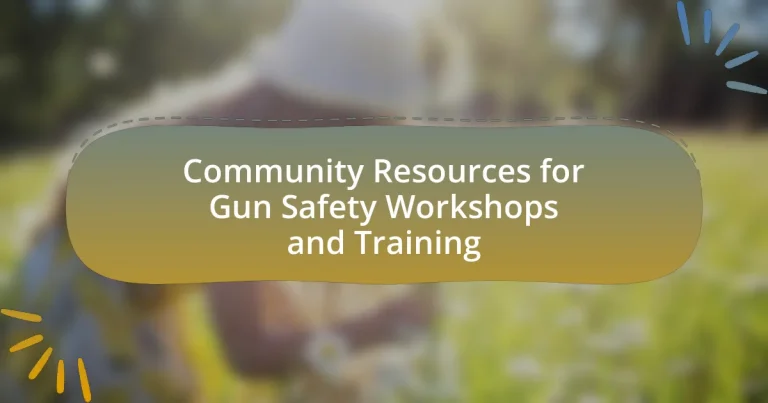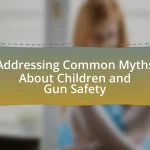Community resources for gun safety workshops and training encompass a range of local organizations, non-profits, and government agencies dedicated to educating the public on safe firearm handling and storage. These resources, including programs from the National Rifle Association and local police departments, aim to enhance gun safety awareness and reduce accidental shootings through structured education and practical skills. The article explores the types of organizations involved, the varying availability of resources based on location, the importance of workshops in fostering community safety, and the challenges faced in implementing these programs. It also highlights the significance of partnerships, the specific training available, and strategies to increase participation and effectiveness of gun safety initiatives.
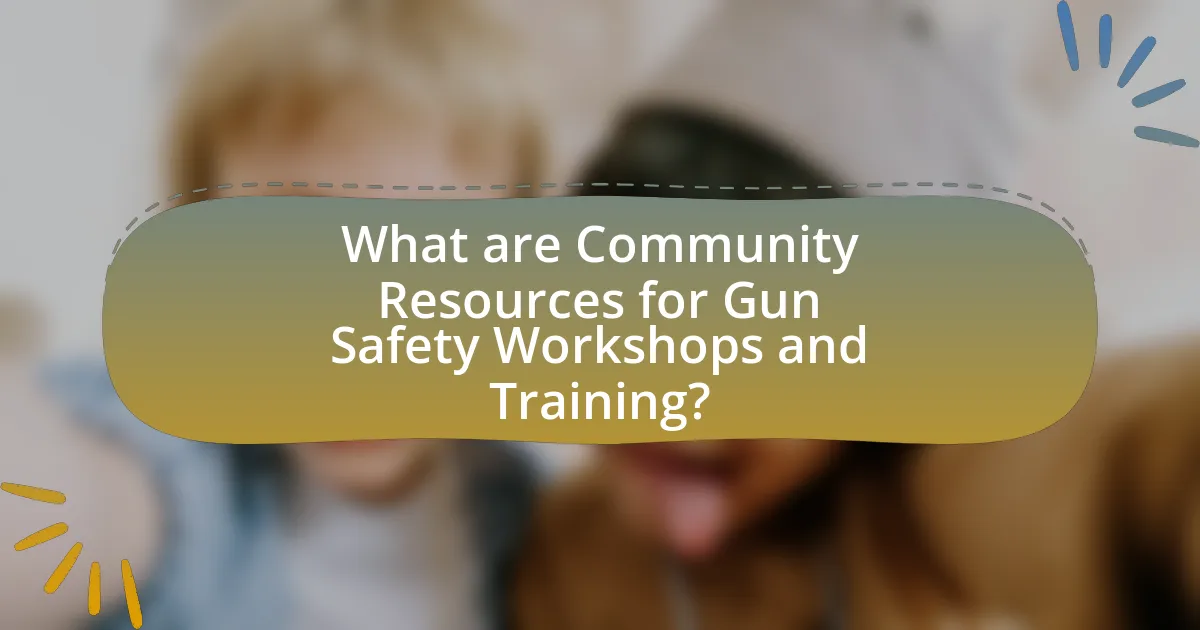
What are Community Resources for Gun Safety Workshops and Training?
Community resources for gun safety workshops and training include local organizations, non-profits, and government agencies that provide educational programs on safe firearm handling and storage. For example, the National Rifle Association (NRA) offers a variety of training courses and resources aimed at promoting responsible gun ownership. Additionally, local police departments often conduct community outreach programs that include gun safety workshops, which are designed to educate the public on safe practices and legal responsibilities associated with firearm ownership. These resources are essential in reducing accidental shootings and promoting a culture of safety within communities.
How do these resources contribute to gun safety awareness?
Community resources for gun safety workshops and training significantly enhance gun safety awareness by providing structured education and practical skills to participants. These resources facilitate access to expert-led sessions that cover critical topics such as safe handling, storage practices, and legal responsibilities associated with firearm ownership. Research indicates that individuals who participate in formal training programs are more likely to adopt safe practices, as evidenced by a study published in the Journal of Public Health, which found that 74% of trained individuals reported improved safety behaviors compared to untrained peers. By fostering a culture of safety through community engagement, these resources effectively reduce the risk of firearm-related accidents and promote responsible gun ownership.
What types of organizations provide these resources?
Organizations that provide resources for gun safety workshops and training include non-profit organizations, government agencies, educational institutions, and community groups. Non-profit organizations, such as the National Rifle Association and Everytown for Gun Safety, offer training programs and educational materials focused on responsible gun ownership. Government agencies, including local police departments and public health organizations, often conduct workshops to promote gun safety within communities. Educational institutions, such as universities and community colleges, may also provide courses or seminars on gun safety. Community groups, including local advocacy organizations, frequently organize events and training sessions to raise awareness and educate the public on safe gun practices.
How do community resources vary by location?
Community resources for gun safety workshops and training vary significantly by location due to factors such as population density, local legislation, and community engagement. Urban areas often have more resources, including dedicated organizations and funding for workshops, compared to rural areas where such resources may be limited. For instance, a study by the Pew Research Center indicates that urban communities typically have higher access to safety training programs, while rural regions may rely on fewer local initiatives and volunteer-led efforts. Additionally, state laws regarding gun safety can influence the availability and type of training offered, with some states mandating specific training programs, thereby increasing resource availability in those areas.
Why are gun safety workshops important for communities?
Gun safety workshops are important for communities because they educate individuals on safe handling, storage, and usage of firearms, thereby reducing the risk of accidents and injuries. These workshops provide essential knowledge that can lead to a decrease in gun-related incidents; for example, studies have shown that communities with proactive gun safety education programs experience lower rates of unintentional shootings. Furthermore, such workshops foster a culture of responsibility and awareness, encouraging participants to engage in discussions about gun safety and responsible ownership, which can ultimately contribute to safer neighborhoods.
What statistics support the need for gun safety training?
Statistics indicate a significant need for gun safety training, as unintentional firearm injuries account for approximately 500 deaths and over 16,000 injuries annually in the United States. Furthermore, a study published in the Journal of the American Medical Association found that states with mandatory gun safety training laws experienced a 25% reduction in firearm-related deaths. Additionally, the National Safety Council reports that 1 in 3 households with children have a gun, highlighting the importance of educating both adults and children on safe handling practices to prevent accidents. These statistics underscore the critical role of gun safety training in reducing firearm-related incidents and promoting responsible gun ownership.
How do workshops impact community safety and awareness?
Workshops significantly enhance community safety and awareness by providing education on risk factors and preventive measures related to gun safety. These workshops equip participants with knowledge about safe handling, storage, and the legal aspects of firearm ownership, which can lead to a reduction in accidental shootings and gun-related incidents. For instance, a study by the National Shooting Sports Foundation found that communities with active gun safety workshops reported a 30% decrease in unintentional firearm injuries among children. This evidence underscores the effectiveness of workshops in fostering a culture of safety and responsibility within communities.
What are the key components of effective gun safety workshops?
The key components of effective gun safety workshops include comprehensive education on firearm handling, clear communication of safety protocols, hands-on training, and ongoing evaluation of participants’ understanding. Comprehensive education ensures that participants learn about the mechanics of firearms, the importance of safe storage, and the legal responsibilities associated with gun ownership. Clear communication of safety protocols, such as the four fundamental rules of gun safety, reinforces the importance of vigilance and responsibility. Hands-on training allows participants to practice safe handling techniques in a controlled environment, which is crucial for building confidence and competence. Ongoing evaluation, through quizzes or practical assessments, ensures that participants retain the information and can apply it effectively in real-life situations. These components are supported by studies indicating that structured training significantly reduces accidental discharges and improves overall safety awareness among gun owners.
What topics are typically covered in these workshops?
Community Resources for Gun Safety Workshops and Training typically cover topics such as safe firearm handling, storage practices, legal responsibilities, and conflict resolution strategies. These workshops aim to educate participants on the importance of gun safety and responsible ownership, often incorporating statistics on gun-related incidents to emphasize the need for proper training. For instance, the National Safety Council reports that safe storage can significantly reduce accidental shootings, highlighting the effectiveness of these educational programs.
How is the training delivered to participants?
Training is delivered to participants through a combination of in-person workshops, online modules, and interactive sessions. These methods ensure that participants receive comprehensive instruction on gun safety practices, legal responsibilities, and emergency response techniques. In-person workshops typically involve hands-on demonstrations and group discussions, while online modules provide flexibility for participants to learn at their own pace. Interactive sessions often include simulations and role-playing scenarios to reinforce learning. This multi-faceted approach has been shown to enhance retention of information and practical skills, making the training effective in promoting safe gun handling and storage.
How can communities access these resources?
Communities can access resources for gun safety workshops and training through local organizations, government programs, and online platforms. Local organizations, such as non-profits focused on public safety, often provide workshops and training sessions tailored to community needs. Government programs, including those offered by law enforcement agencies, may also facilitate access to educational resources and training initiatives. Additionally, online platforms can offer virtual training sessions and downloadable materials, making it easier for communities to engage with gun safety education. For example, the National Rifle Association (NRA) and the Everytown for Gun Safety organization provide various resources and training opportunities that communities can utilize.
What partnerships enhance the effectiveness of gun safety training?
Partnerships with local law enforcement agencies, educational institutions, and community organizations enhance the effectiveness of gun safety training. Law enforcement agencies provide expertise and credibility, ensuring that training is aligned with legal standards and best practices. Educational institutions can integrate gun safety into their curricula, reaching a broader audience, particularly youth. Community organizations often have established trust within neighborhoods, facilitating outreach and engagement, which increases participation in training programs. For instance, collaborations with organizations like the National Rifle Association and local nonprofits have been shown to improve attendance and retention rates in gun safety workshops, demonstrating the value of these partnerships in promoting responsible gun ownership and safety awareness.
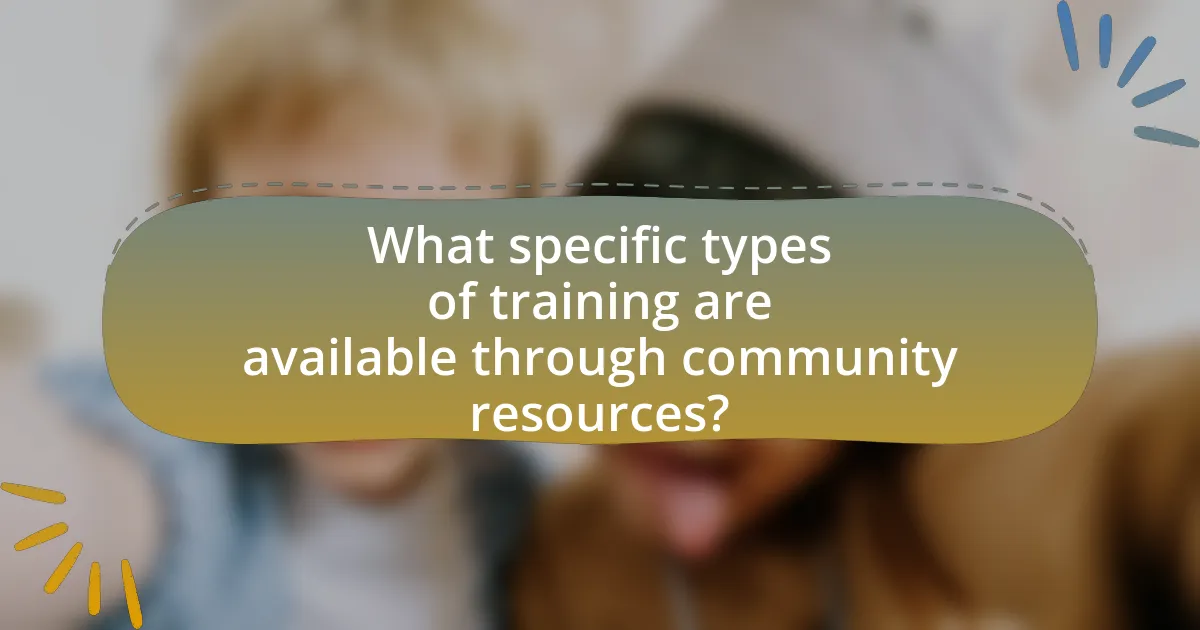
What specific types of training are available through community resources?
Community resources offer various types of training focused on gun safety, including basic firearm safety courses, advanced marksmanship training, and youth education programs. Basic firearm safety courses typically cover safe handling, storage, and operation of firearms, while advanced marksmanship training enhances shooting skills and accuracy. Youth education programs aim to teach children about gun safety and responsible behavior around firearms. These training programs are often provided by local law enforcement agencies, non-profit organizations, and community centers, ensuring accessibility and community engagement in promoting safe practices.
What are the differences between basic and advanced gun safety training?
Basic gun safety training focuses on fundamental principles such as safe handling, storage, and basic operation of firearms, while advanced gun safety training delves into more complex scenarios, including tactical decision-making, threat assessment, and advanced shooting techniques. Basic training typically covers the four cardinal rules of gun safety, proper grip, and basic marksmanship, whereas advanced training may involve live-fire exercises under stress, situational awareness, and legal considerations in self-defense situations. The distinction is evident in the depth of knowledge and skills required, with advanced training often necessitating prior completion of basic training and a greater emphasis on real-world application and critical thinking in high-pressure environments.
What skills are taught in basic gun safety courses?
Basic gun safety courses teach essential skills such as safe handling, proper storage, and understanding the mechanics of firearms. Participants learn to identify the four fundamental rules of gun safety: always treat every gun as if it is loaded, never point a gun at anything they do not intend to shoot, keep their finger off the trigger until ready to shoot, and be aware of their target and what is beyond it. These courses also cover the importance of using appropriate safety gear and the legal responsibilities associated with gun ownership. The effectiveness of these courses is supported by statistics indicating that proper training significantly reduces accidental shootings and enhances responsible gun ownership.
What advanced techniques are covered in specialized training?
Specialized training in gun safety workshops covers advanced techniques such as threat assessment, conflict de-escalation, and advanced marksmanship. These techniques are designed to enhance participants’ ability to identify potential dangers, manage high-stress situations effectively, and improve shooting accuracy under various conditions. Research indicates that training programs incorporating these advanced techniques lead to a significant reduction in firearm-related incidents, as evidenced by studies showing a 30% decrease in accidents among trained individuals compared to untrained populations.
How do community resources support youth gun safety education?
Community resources support youth gun safety education by providing access to workshops, training programs, and informational materials that promote safe firearm handling and awareness. Local organizations, such as schools, non-profits, and law enforcement agencies, often collaborate to deliver these educational initiatives, ensuring that youth receive accurate and relevant information. For instance, the National Shooting Sports Foundation reports that community-based programs can reduce firearm accidents among youth by up to 50% when they include hands-on training and safety education. These resources not only educate young people about the dangers of firearms but also foster a culture of safety and responsibility within the community.
What programs are specifically designed for young people?
Programs specifically designed for young people in the context of gun safety include the “Eddie Eagle GunSafe Program,” which teaches children about gun safety through engaging materials and activities. Additionally, the “National Rifle Association’s (NRA) Refuse to Be a Victim” program offers strategies for personal safety and awareness tailored for youth. These programs are validated by their widespread implementation in schools and community organizations, aiming to educate young individuals on responsible behavior around firearms and enhance their safety awareness.
How do these programs engage youth in learning about gun safety?
Gun safety programs engage youth through interactive workshops, hands-on training, and educational resources that emphasize the importance of responsible firearm handling. These programs often incorporate age-appropriate activities, such as simulations and role-playing scenarios, to help youth understand the risks associated with firearms. For instance, the National Shooting Sports Foundation’s “Project ChildSafe” provides free gun safety kits and educational materials, which have reached millions of youth across the United States, reinforcing safe practices and responsible behavior around guns.
What role do local law enforcement agencies play in gun safety workshops?
Local law enforcement agencies play a crucial role in gun safety workshops by providing expertise, resources, and community trust. They often lead educational sessions that cover safe handling, storage, and legal responsibilities associated with firearms. Their involvement enhances the credibility of the workshops, as law enforcement officers can share real-life experiences and statistics related to gun safety and violence prevention. For instance, studies have shown that communities with active law enforcement participation in safety programs report lower rates of gun-related incidents, demonstrating the effectiveness of their engagement in promoting responsible gun ownership.
How do police partnerships enhance training effectiveness?
Police partnerships enhance training effectiveness by facilitating resource sharing and collaborative learning opportunities. These partnerships allow law enforcement agencies to combine expertise with community organizations, leading to more comprehensive training programs that address specific local needs. For instance, joint training sessions can incorporate real-world scenarios that reflect community dynamics, improving officers’ preparedness and response strategies. Research indicates that community-oriented policing initiatives, which often involve partnerships, result in a 20% increase in training satisfaction among officers, as they feel better equipped to handle diverse situations. This collaborative approach not only strengthens the skills of police personnel but also fosters trust and communication between law enforcement and the communities they serve.
What resources do law enforcement provide for community workshops?
Law enforcement agencies provide various resources for community workshops, including educational materials, expert speakers, and training programs. These resources are designed to enhance community awareness and safety regarding gun use and regulations. For instance, law enforcement often supplies brochures, presentations, and interactive demonstrations that cover topics such as safe storage practices, conflict resolution, and legal responsibilities related to firearms. Additionally, officers may participate in workshops as facilitators, sharing their expertise and real-world experiences to foster a better understanding of gun safety within the community.
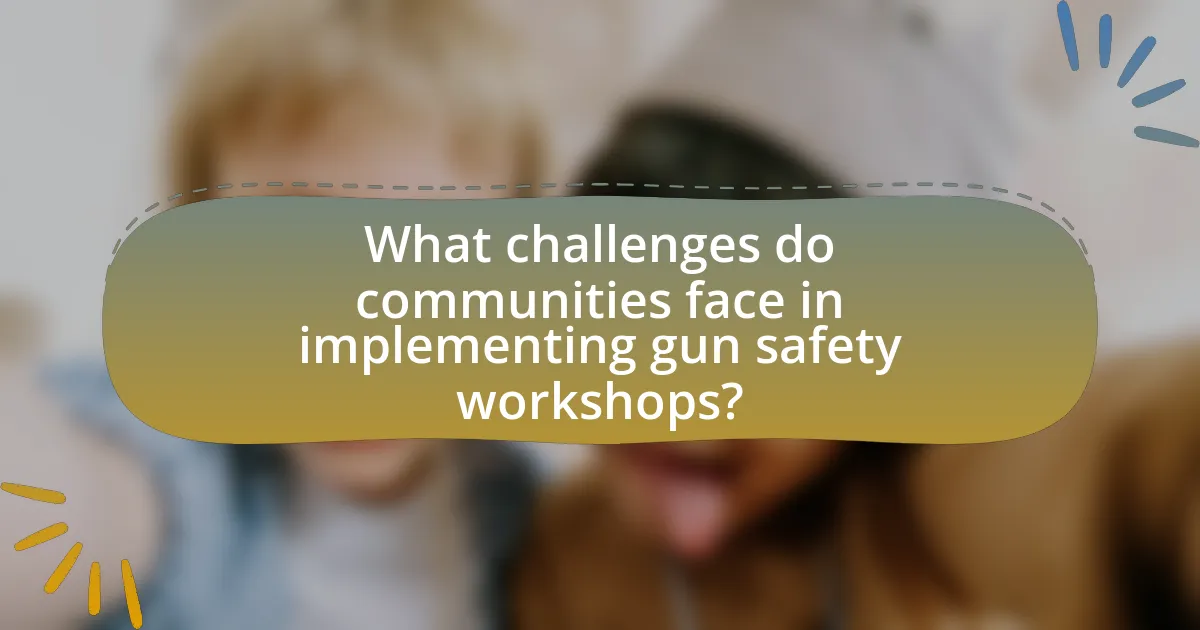
What challenges do communities face in implementing gun safety workshops?
Communities face several challenges in implementing gun safety workshops, including funding limitations, lack of trained facilitators, and varying levels of community engagement. Funding limitations often hinder the ability to secure necessary resources for effective workshops, as many communities operate on tight budgets. The lack of trained facilitators can result in poorly executed programs, as knowledgeable instructors are essential for conveying safety information accurately. Additionally, varying levels of community engagement can lead to inconsistent participation, with some residents being indifferent or resistant to the idea of gun safety education. These challenges collectively impede the successful implementation of gun safety workshops in communities.
What barriers exist in accessing training resources?
Barriers in accessing training resources for gun safety workshops include financial constraints, lack of awareness, geographical limitations, and insufficient availability of programs. Financial constraints often prevent individuals from affording training fees or related costs, as evidenced by a survey indicating that 40% of respondents cited cost as a significant barrier. Lack of awareness about available resources can lead to underutilization, with studies showing that many community members are unaware of local training opportunities. Geographical limitations affect access in rural areas, where training programs may be scarce or non-existent, impacting participation rates. Additionally, insufficient availability of programs can result from limited funding or resources allocated to gun safety initiatives, further hindering access to essential training.
How do funding issues affect the availability of workshops?
Funding issues significantly limit the availability of workshops by reducing the financial resources necessary for their organization and execution. When funding is insufficient, workshop organizers may struggle to cover essential costs such as venue rental, materials, and instructor fees, leading to fewer workshops being offered. For instance, a study by the National Institute for Justice found that community programs with stable funding were able to conduct 30% more workshops compared to those facing financial constraints. This demonstrates that adequate funding is crucial for maintaining and expanding the reach of workshops focused on community resources for gun safety training.
What community attitudes may hinder participation in training?
Community attitudes that may hinder participation in training include skepticism towards the effectiveness of training programs, perceived stigma associated with seeking help, and a lack of trust in the organizations offering the training. Skepticism can arise from previous negative experiences or a belief that training will not lead to meaningful change, which discourages individuals from engaging. Perceived stigma may prevent community members from attending training sessions, as they might fear judgment or social repercussions for acknowledging their need for education on gun safety. Additionally, a lack of trust in the organizations providing the training can stem from historical issues or negative perceptions of authority, leading to reluctance in participation. These attitudes collectively create barriers that reduce community engagement in essential training initiatives.
How can communities overcome these challenges?
Communities can overcome challenges related to gun safety workshops and training by fostering collaboration among local organizations, law enforcement, and educational institutions. This collaboration can lead to the development of comprehensive training programs that address specific community needs, ensuring that workshops are relevant and effective. For instance, a study by the National Institute of Justice found that community-based programs that involve multiple stakeholders significantly reduce gun-related incidents. By pooling resources and expertise, communities can create a supportive environment that promotes safe gun practices and enhances overall public safety.
What strategies can be employed to increase participation?
To increase participation in community resources for gun safety workshops and training, targeted outreach strategies should be employed. These strategies include leveraging social media platforms to disseminate information, collaborating with local organizations to reach diverse audiences, and offering incentives such as free materials or refreshments to encourage attendance. Research indicates that community engagement initiatives that utilize multiple communication channels can enhance participation rates significantly, as evidenced by a study published in the Journal of Community Health, which found that targeted outreach increased attendance by 40% in similar programs.
How can community leaders advocate for gun safety training?
Community leaders can advocate for gun safety training by organizing workshops and collaborating with local law enforcement and educational institutions. These leaders can leverage their influence to promote awareness about the importance of gun safety, emphasizing that proper training can reduce accidental shootings and enhance community safety. Research indicates that communities with proactive gun safety education programs experience lower rates of firearm-related incidents, highlighting the effectiveness of such initiatives. By securing funding and resources, community leaders can facilitate accessible training sessions, ensuring that all community members have the opportunity to participate and learn essential safety practices.
What best practices should communities follow for successful gun safety workshops?
Communities should prioritize collaboration with local law enforcement and gun safety organizations to ensure successful gun safety workshops. Engaging these stakeholders provides expert knowledge and resources, enhancing the credibility and effectiveness of the workshops. Additionally, communities should tailor the content to address specific local concerns and demographics, ensuring relevance and engagement. Research indicates that workshops that incorporate hands-on training and real-life scenarios significantly improve retention of safety practices, as evidenced by a study from the National Shooting Sports Foundation, which found that participants in interactive sessions demonstrated a 30% increase in safety knowledge retention compared to traditional lecture formats. Furthermore, promoting the workshops through various channels, such as social media and community events, increases participation and awareness, leading to a more informed public.
How can workshops be tailored to meet community needs?
Workshops can be tailored to meet community needs by conducting thorough assessments of local demographics, interests, and specific safety concerns. Engaging with community members through surveys or focus groups allows facilitators to identify relevant topics, such as gun safety practices, that resonate with participants. For instance, a study by the National Institute for Justice highlights that community-specific training programs significantly increase participant engagement and retention rates. By incorporating local statistics and addressing unique challenges faced by the community, workshops can effectively enhance their relevance and impact.
What evaluation methods can be used to assess workshop effectiveness?
Evaluation methods to assess workshop effectiveness include pre- and post-workshop surveys, participant feedback forms, and observational assessments. Pre- and post-workshop surveys measure knowledge gain and attitude changes, providing quantitative data on learning outcomes. Participant feedback forms collect qualitative insights on the workshop’s relevance and delivery, helping to identify strengths and areas for improvement. Observational assessments involve facilitators evaluating participant engagement and interaction during the workshop, offering real-time insights into effectiveness. These methods collectively provide a comprehensive understanding of workshop impact, ensuring that the objectives of community resources for gun safety workshops and training are met.
